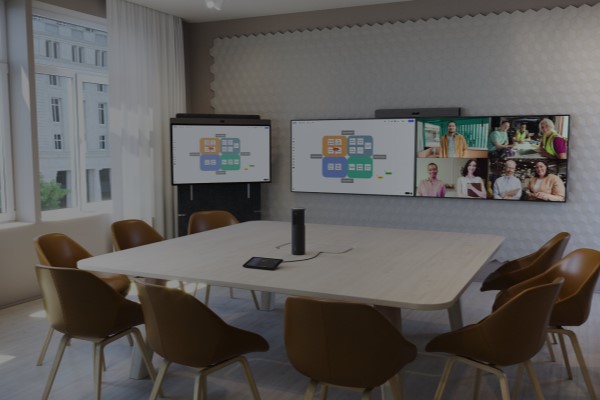The future of video collaboration according to Neat
As we approach 2025, the video collaboration landscape is set for another remarkable transformation. With advancements in AI and the seamless integration of innovative collaboration tools, the way we connect, work as one team and innovate is about to evolve, promising to redefine how we work together – no matter where we are!
In this commentary, we will explore four exciting trends shaping the future of video collaboration, including enhanced user experiences that prioritise meeting equity and the rise of intelligent meeting environments tailored to workforce needs.
ADVERTISEMENT
Trend #1: The hybrid work model will require rewiring the workplace to meet employee needs
The hybrid work model in Australia and New Zealand is set to remain dominant in 2025. With average occupancy in Australia’s CBD reaching 76% compared to pre-Covid levels in Q1 2024, hybrid work will continue to be central to office design and facilities management strategies. This approach will blend technology and human connection, transforming virtual meetings into immersive experiences that foster collaboration and creativity.
However, despite the positives around hybrid work, companies are concerned about potential productivity losses, the lack of connection and escalating costs. Expect to see organisations simplifying their meeting environments to address such challenges. These include reducing total cost of ownership (TCO) by integrating essential components – such as microphones, speakers, and DSPs – into a single device. This integration eliminates the need for unnecessary complexities and additional costs such as multiple devices or relying on third-party schedulers, allowing organisations to focus on what truly matters: effective collaboration.
Traditional boardroom setups will give way to solutions that promote meeting equity, ensuring remote participants feel as if they are in the same room – the holy grail of video communications! For example, Neat’s technology creates a “digital roundtable” where everyone has a seat, is seen and heard. This “symmetry” in the meeting experience fosters better collaboration and engagement, making every voice count.
Trend #2: AI technology will make video collaboration tools more intelligent, immersive and user-friendly
AI advancements will further enhance video collaboration tools, introducing innovative features like real-time transcription, automated meeting summaries and smart scheduling to streamline workflows and boost productivity.
However, they also raise security concerns, particularly with the rise of deepfake technology posing challenges for voice recognition systems. Organisations must implement robust security protocols, such as secure access and authentication methods like multi-factor authentication, to safeguard access to virtual meetings.
Additionally, CISOs are understandably cautious about the implications of these technologies on security. While Neat ensures compliance with security standards from platforms like Microsoft and Zoom, the ultimate responsibility for security lies with the service providers. As significant events such as the upcoming Australian elections approaches, discussions around legislation and security protocols will become increasingly relevant.
Trend #3: 5G will promote equity by boosting video conferencing demand in rural regions
The rollout of 5G technology, now reaching over 87% of Australia’s population, will revolutionise the video conferencing landscape next year, particularly in rural areas where connectivity has historically been a challenge. Users in these areas can expect enhanced video quality and reduced latency, making virtual meetings more stable and engaging.
These improvements will not only enhance video conferencing but also promote equity across the country, enabling industries such as oil and gas, mining, education, and healthcare, particularly those in the emergency services to operate more effectively. For example, remote command centres will require high-quality video calls to coordinate responses during emergencies, and reliable networks will be essential for this.
However, challenges remain, particularly with the limitations imposed by platforms like Microsoft and Zoom. While Neat’s technology can deliver high-resolution images, these platforms may struggle to keep up with the demands of 5G, potentially hamstringing the overall experience. Additionally, while satellite technology could enhance connectivity in emergency situations, network reliability is still a critical factor that needs addressing.
Trend #4: Legislative reforms will encourage organisations to balance security with innovation
New government policies around AI, data privacy and cybersecurity will greatly impact the adoption of video collaboration technologies. For one, organisations are mandated to meet transparency and accountability requirements by specific deadlines.
As threats like deepfakes and identity theft increase, the need for strong security, compliance and data governance in video conferencing becomes paramount. Organisations must stay updated on the latest security practices and emerging threats, while also educating employees about the importance of maintaining a secure communication environment. Clear policies and standards must be established to ensure that all employees understand their rights and responsibilities, especially regarding the use of AI in the workplace. Notably, Gartner predicts that by 2028, 40% of large enterprises will deploy AI to analyse employee mood and behaviour, raising ethical considerations about privacy and consent.
As government regulations tighten, AI-driven features in video collaboration solutions will be critical to ensure secure communication across teams, helping organisations comply with the regulatory reforms while also boosting productivity and enhanced collaboration.
The hybrid work model is set to evolve significantly by 2025, driven by advancements in technology, AI integration and the rollout of 5G. Organisations must adapt to these changes by prioritising user experience, security and effective communication. By embracing these trends, companies can create a collaborative environment that meets the needs of their employees while fostering innovation and growth. Neat is committed to leading this transformation, ensuring seamless, high-quality video communication for all users, regardless of their location.
Jason MacBride is Neat’s regional director for ANZ. Jason leads Neat’s growth in the Australia and New Zealand region, focusing on driving customer and channel growth as well as expanding into vertical markets. With over seven years of experience in video collaboration technology, Jason is well-positioned to comment on the current trends within the digital landscape.
-
ADVERTISEMENT
-
ADVERTISEMENT
-
ADVERTISEMENT
-
ADVERTISEMENT

